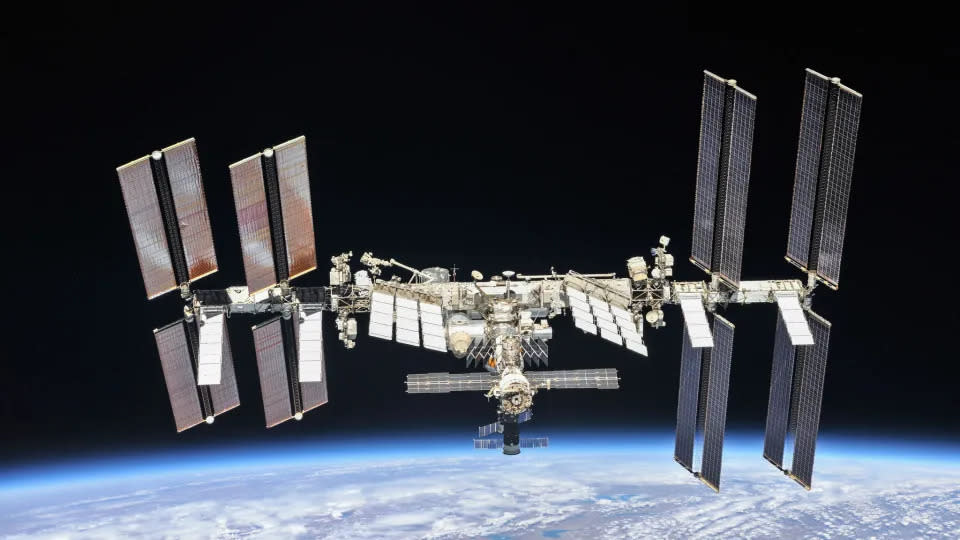SpaceX to build vehicle that will drag the International Space Station out of orbit

Sign up for CNN’s Wonder Theory science newsletter. Explore the universe with news on fascinating discoveries, scientific advancements and more.
NASA will pay SpaceX up to nearly $1 billion to develop a vehicle capable of steering the International Space Station out of orbit to its final resting place when the federal agency and its partners retire the orbiting laboratory in the coming years.
The SpaceX-made vehicle could launch later this decade. It would latch onto the International Space Station — a nearly 1 million-pound structure roughly the size of a football field — and guide the craft as it plunges out of Earth’s orbit. The deorbit vehicle and the space station are expected to slam back into the thick planetary atmosphere while still traveling more than 17,000 miles per hour (27,359 kilometers per hour).
SpaceX will receive up to $843 million for the task, NASA said Wednesday. The space agency declined to say how many companies submitted proposals for the deorbit vehicle contract.
The federal agency operates the International Space Station alongside Roscosmos, the Russian space agency, which controls a key wing of the station and propulsion modules. The Japan Aerospace Exploration Agency, or JAXA, the European Space Agency and the Canadian Space Agency also play roles in its operations.
NASA noted in a Wednesday news release that “the safe deorbit of the International Space Station is the responsibility of all five space agencies.”
The federal agency, however, did not say if its international partners would shoulder some of the cost of SpaceX’s contract for building the deorbit vehicle. A spokesperson for NASA did not immediately respond to a request for comment on the matter.
SpaceX also did not respond to a list of emailed questions regarding the contract. The company typically doesn’t respond to inquiries from news organizations.
In prior documents, NASA said that it hoped the deorbit vehicle could be launched by December 2028. But the space agency stipulated that it would only require that the vehicle be ready by 2029.
Exactly when the space station will cease operations is not clear.
In the news release, NASA noted that it is committed to continuing space station operations through 2030. But Roscosmos has only guaranteed its participation through “at least 2028.”
NASA has stressed that the space station provides a crucial platform for its astronauts to conduct science experiments and carry out research for future missions deeper into the cosmos, but the laboratory is rapidly aging.
The station, which is in orbit about 250 miles (400 kilometers) above Earth’s surface, has hosted rotating crews of astronauts continuously since 2000.
“Selecting a U.S. Deorbit Vehicle for the International Space Station will help NASA and its international partners ensure a safe and responsible transition in low Earth orbit at the end of station operations,” Ken Bowersox, associate administrator for NASA’s Space Operations Mission Directorate, said in a statement. “The orbital laboratory remains a blueprint for science, exploration, and partnerships in space for the benefit of all.”
NASA has long said that it plans to hand over operations in low-Earth orbit — the area of space closest to Earth where the space station currently operates — to the private sector. Commercial companies will be free to build their own orbiting laboratories, space hotels or other ventures.
Meanwhile, NASA plans to turn its focus to exploring deeper into the solar system. The agency’s Artemis program, for example, seeks to return astronauts to the moon’s surface by 2026 and eventually establish a permanent lunar outpost.
In a separate announcement, NASA also said Wednesday afternoon that it was ending a contract to develop new Extravehicular Activity, or EVA, spacesuits — which astronauts wear when they conduct spacewalks outside the station.
The iconic puffy white suits that astronauts currently wear on spacewalks were designed more than 40 years ago. Earlier this week, NASA was forced to wave off plans to remove a faulty electronics box outside the space station because a spacesuit worn by astronaut Tracy Dyson sprung a leak shortly before the spacewalk began.
In a statement announcing the decision Wednesday, NASA said that its partner on the EVA contract, North Carolina-based Collins Aerospace, “recognized its development timeline would not support the space station’s schedule and NASA’s mission objectives.”
For more CNN news and newsletters create an account at CNN.com

 Yahoo News
Yahoo News 
